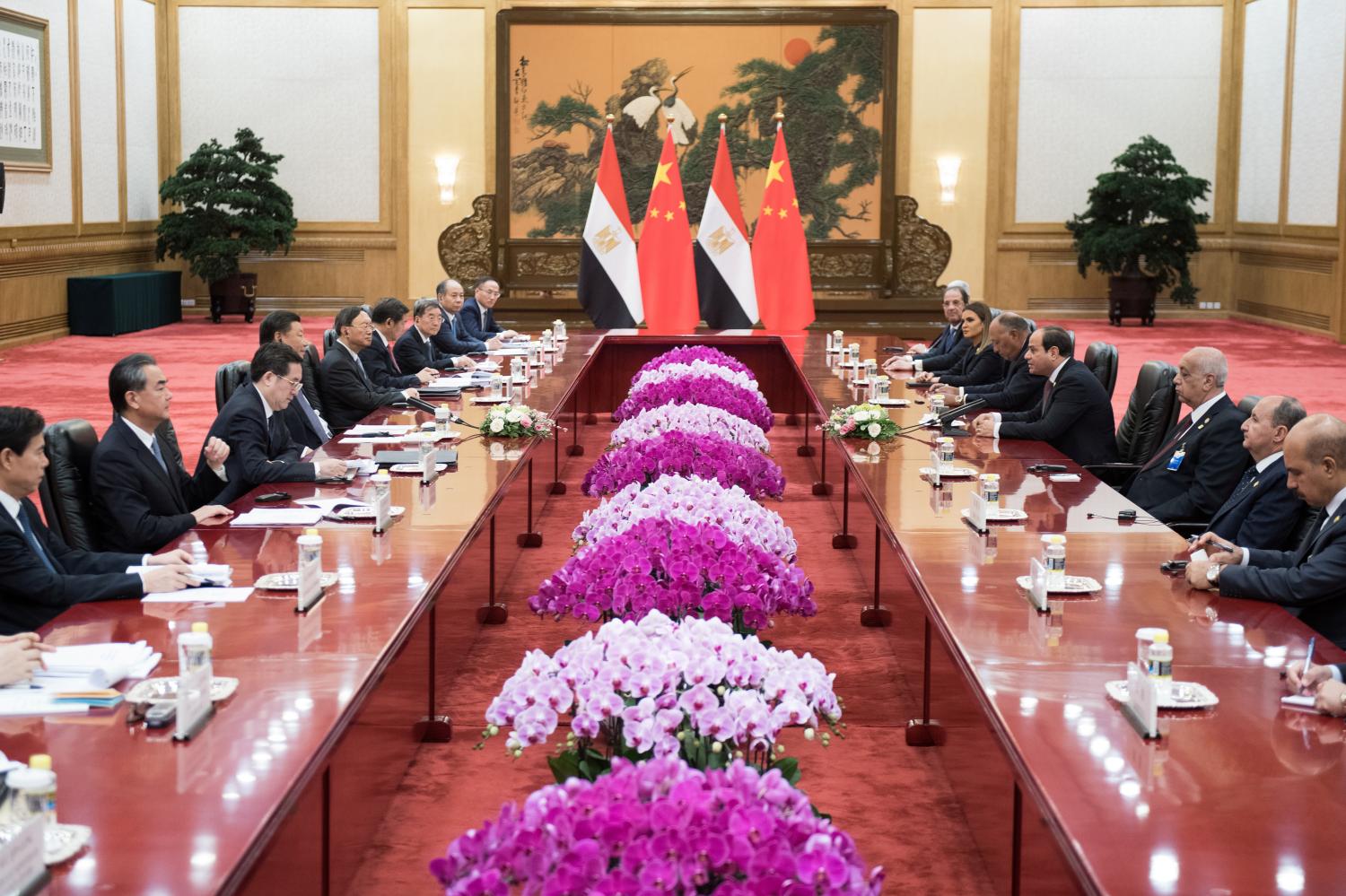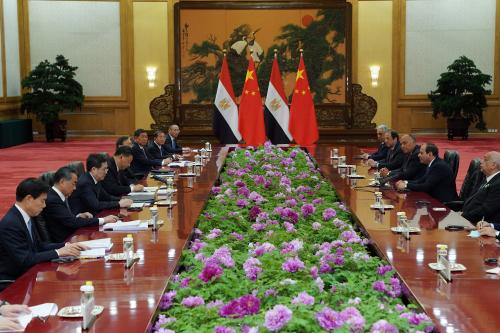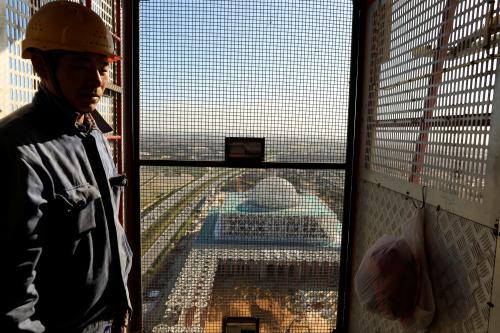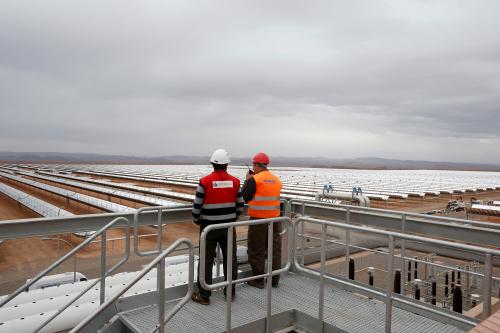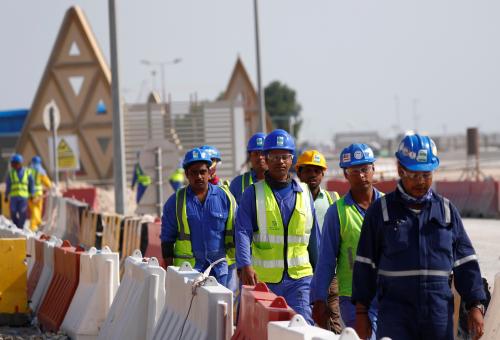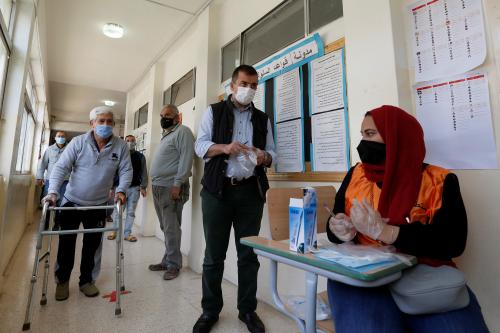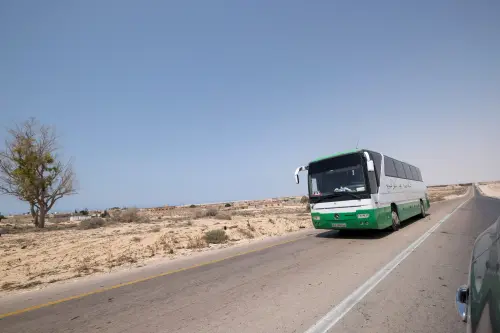Content from the Brookings Doha Center is now archived. In September 2021, after 14 years of impactful partnership, Brookings and the Brookings Doha Center announced that they were ending their affiliation. The Brookings Doha Center is now the Middle East Council on Global Affairs, a separate public policy institution based in Qatar.
Introduction
As the United States slowly disengages from the Middle East, and as Europe faces internal challenges, a new actor is quietly exerting greater influence across North Africa. China has been strategically ramping up engagement with countries such as Egypt, Algeria, and Morocco, which lie at the intersection of three key regions: the Middle East, Africa, and the Mediterranean. Beijing’s growing footprint in these countries encompasses, but is not limited to, trade, infrastructure development, ports, shipping, financial cooperation, tourism, and manufacturing.
Through this engagement, China is setting up North Africa to play an integral role in connecting Asia, Africa, and Europe — a key aim of President Xi Jinping’s Belt and Road Initiative (BRI). Previous analyses of the BRI’s role in the Middle East and North Africa (MENA) region have emphasized that the initiative is difficult to define, with its exact scope subject to much debate.1 While the current BRI map only officially includes Egypt, BRI Memorandums of Understanding (MoUs) have been signed between China and every state in North Africa, demonstrating that it is expanding its foothold in the region.
China is expanding its cooperation with North African countries, not only in the economic and cultural spheres, but also those of diplomacy and defense. Furthermore, it is showcasing a development model that seeks to combine authoritarianism with economic growth — a model that has an eager audience among regimes across the MENA region. As such, China’s growing role in North Africa is likely to have far-reaching economic and geopolitical consequences for countries in the region and around the world.
This policy briefing seeks to analyze China’s growing role in North Africa. It will begin by providing background and context on China’s relations with Algeria, Egypt, Morocco, Tunisia, and Libya. Then, it will provide an overview of the soft and hard power elements of Chinese influence in North Africa, with a particular emphasis on soft power.2 Lastly, it will offer a set of policy recommendations aimed at North African, European, and U.S. policymakers.
As part of these policy recommendations, this briefing argues that China’s engagement should be cautiously welcomed, but also closely monitored, by governments in North Africa, Europe, and the United States. North African governments should be wary of Chinese “debtbook diplomacy” and surveillance, while Western governments should be wary of the security consequences of an increased Chinese presence in the Mediterranean. Moving forward, China, North Africa, Europe, and the United States should seek win-win modalities of engagement that bring prosperity and stability to the Mediterranean basin.
Background and Context
China’s relationship with the countries of North Africa, especially Algeria and Egypt, began during the anticolonial struggle, stemming from an ideological support for national liberation movements. Notably, China was the first non-Arab country to recognize Algeria and provided political and military support for its revolutionary struggle. However, the basis of China’s interest in North Africa shifted away from “revolutionary romanticism,” and toward economic and strategic concerns, at the end of the twentieth century.3
In the wake of the 2008 recession and the Eurozone crisis, North African states, which have historically relied on trade and investment from Europe and the United States, worked to diversify their markets and economic partners.4 During the same period, China’s economy maintained impressive momentum, boasting a 9.5 percent GDP growth rate in 2011.5 Despite slower economic growth in recent years,6 China has promoted its economic and soft power through the BRI, which is the principle foreign policy initiative of the Xi Jinping era.
Launched in 2013, this initiative is set to cost around $1 trillion, according to some estimates, and to include over 80 countries, which are responsible for around 36 percent of global GDP and 41 percent of global trade.7 South Asia has so far received the majority of BRI projects, but the initiative’s expansion west, toward Europe and the MENA region, is well underway. While China’s economic presence in Africa and Asia has been the subject of much study and scrutiny, the relationship between China and North Africa deserves more attention. This developing relationship reveals key trends and sheds light on China’s strategic priorities, as well as on how countries like Morocco, Algeria, Tunisia, Libya, and Egypt are increasing cooperation with new foreign partners.
China engages in two main types of “partnership diplomacy” in the MENA region: strategic partnerships (SPs) and comprehensive strategic partnerships (CSPs).8 According to Strüver’s study of Chinese partnership diplomacy, relations between partner countries under an SP have the following four characteristics:
- They go beyond typical diplomatic relations, involving consistent meetings between government officials and agencies to develop communication and trust.
- They do not fall within the confines of treaty-based alliances or coalitions.
- They are more ‘goal-driven’ than ‘threat-driven,’ typically focusing on areas of mutual cooperation in economics, culture, security, and technology.
- They are characterized by an emphasis on behavior and institutional processes.9
In comparison with SPs, CSPs involve a higher level of institutional communication, including regular high-level meetings between top leadership members of both partner countries. Strüver notes that “Three conditions have to be met before an agreement on a… [CSP] can be achieved, i.e. political trust, dense economic ties, cultural exchanges, and good relations in other sectors.”10
As the table below illustrates, China has established CSPs with Algeria and Egypt and an SP with Morocco. These include dozens of MoUs and promises for major infrastructure and development projects. It is worth noting that, while China has signed BRI MoUs with Libya and Tunisia, it has yet to establish a formal partnership with either North African state.11China’s Partner Countries in the MENA region, 2012-July 201612
 These partnerships demonstrate how China and North African states have strengthened their diplomatic, economic, and cultural relations in recent years, especially since the BRI was launched. Across the region, Chinese Cultural Centers and Confucius Institutes have been opened, while visa restrictions and travel advisories for Chinese tourists have been lifted, causing tourism to expand rapidly. Chinese diplomats at both the Rabat and Cairo embassies said that these strengthened relations reflect the key BRI aim of promoting connectivity and economic development in five priority areas: policy coordination, infrastructure connectivity, increased trade, financial integration, and people-to-people exchanges.13
These partnerships demonstrate how China and North African states have strengthened their diplomatic, economic, and cultural relations in recent years, especially since the BRI was launched. Across the region, Chinese Cultural Centers and Confucius Institutes have been opened, while visa restrictions and travel advisories for Chinese tourists have been lifted, causing tourism to expand rapidly. Chinese diplomats at both the Rabat and Cairo embassies said that these strengthened relations reflect the key BRI aim of promoting connectivity and economic development in five priority areas: policy coordination, infrastructure connectivity, increased trade, financial integration, and people-to-people exchanges.13
China’s establishment of CSPs with both Egypt and Algeria reflects the major role these states play in the MENA region, as well as the fact that these are its two key bilateral relationships in the region in terms of trade, arms sales, and infrastructure projects. In turn, China has become the top trading partner for both Egypt and Algeria.14
Algeria is a major supplier of oil and gas to Europe, as well as a key economic and security actor in the Mediterranean, North African, and Sahel regions. It has the largest military budget in Africa, having spent $9.6 billion in 2018,15 and arguably acts as a leading “regional security provider.”16 Algeria has worked to mediate various regional conflicts, such as those in Mali and Libya, and has historically acted as a gateway to Africa, as well as to key regional blocs, such as the African Union.
Meanwhile, Egypt controls one of the most strategic waterways in the world, the Suez Canal, and is becoming a major gas hub in the eastern Mediterranean.17 It also acts as another major regional security provider, managing one of the largest military forces in Africa.18 In addition, Egypt is allied with the Saudi-Emirati axis, which has sought to exert influence in Libya, Sudan, and elsewhere in the MENA region.
While China’s relations with Egypt and Algeria are characterized by a robust diplomatic and security partnership, its growing presence in countries like Morocco and Tunisia remains primarily economic and cultural. In Libya, Chinese firms have ceased operations due to ongoing instability, though the prime minister of the internationally recognized Government of National Accord (GNA), Fayez Serraj, has said that they are welcome to return.19
Overall, the strategic location of these five countries on the southern shores of the Mediterranean means that China’s presence will only continue to expand, especially in the economic realm. Notably, China’s relations with these countries are framed by its official policy of non-interference in political affairs, in contrast to the policies of historical Western partners. Likewise, these five countries, to varying extents, increasingly view China as a viable alternative partner to Europe and the United States, leading them to expand their cooperation with Beijing, not only on economic and cultural matters, but also on diplomacy and defense issues.
Soft Power: Economic and Cultural Pillars
Chinese policy in North Africa combines both soft power and hard power elements, but soft power has been particularly prominent in Chinese discourse.20 While many types of economic power are understood to be forms of hard power, China engages in a softer form of economic influence, using economic diplomacy “more as carrots than as sticks.”21 The commercial side of Chinese influence in North Africa is directly related to the growing legitimacy of the Chinese development model, which emphasizes economic development and non-interference in political affairs, in contrast to the traditional Western emphasis on advocating for liberal and democratic norms. In line with these observations, this paper defines soft power to include economic and commercial relations, based on an understanding of how China uses trade, investment, and finance as noncoercive tools in its relations with North African countries.
Currently, most BRI engagement in North Africa is tied to economic and commercial relations, giving the involved countries the opportunity to increase trade volumes, foreign investments, tourism revenues, and the number of manufacturing bases. This has also had the effect of encouraging competition among traditional Western partners, such as the European Union,22as well as China and Russia. Chinese diplomats stress that North African countries are especially attractive prospects for economic cooperation due to their proximity to European, African, and Asian markets, high number of industrial zones, and high levels of investment in infrastructure development.23Trade
From Morocco to Egypt, China is increasingly trading with and investing in North African countries. Its economic strategies differ from country to country, with Egypt, Morocco, and Algeria representing its highest priorities. According to the Egyptian Ministry of Trade and Industry, Egypt is China’s third largest trading partner in Africa.24 In 2017, the trade volume between the two countries reached $10.87 billion,25 while the value of Egypt’s imports from China was over $8 billion, the highest in North Africa.26 In the first eight months of 2018, bilateral trade between Egypt and China jumped by around 26 percent.27 China’s trade with Morocco is more modest, but is gradually expanding; Morocco’s imports from China were worth $3.14 billion in 2017, behind only those from France and Spain.28
Algeria, meanwhile, is one of China’s oldest and largest economic partners in North Africa. China became Algeria’s top trade partner in 2013, overtaking France. However, there is a significant trade deficit. While China has become Algeria’s primary source for imports, which were valued at $7.85 billion in 2018,29 Algeria’s exports to China remain relatively insignificant compared to its exports to European countries, and are almost entirely from the hydrocarbon sector. However, its exports to China are rising, having jumped 60-fold between 2000 and 2017.30
Trade has also risen between China and Tunisia, with the latter’s imports from the former valued at $1.85 billion in 2017, ranking third behind France and Italy.31However, one Chinese diplomat argued that China still views the country as an investment risk and is skeptical of its democratic transition and economic challenges.32
After civil war broke out in Libya in 2011, China and many other countries were forced to evacuate their citizens and pull out of major projects and investments. However, Libya’s oil exports to China have more than doubled since 2017,33and China is eyeing post-reconstruction opportunities. In July 2018, GNA foreign minister Mohamed Sayala signed an MoU with his Chinese counterpart, paving the way for Libya to join the BRI. Unlike other regional powers, the Chinese have not taken sides in the Libyan conflict because of their commitment to political non-interference. This puts them in a strong position to make deals with whichever government takes the lead of Libya in the future.
Investment and Infrastructure
In Algeria, Chinese companies are primarily interested in the construction, housing, and energy sectors. Major Chinese-funded and/or built construction projects, such as the Algiers Opera House, the Sheraton Hotel, the Great Mosque of Algiers, and the East-West Highway, mark the landscape, as do the thousands of Chinese workers who have established a “Chinatown” in a suburb of Algiers.
The Chinese presence in Morocco and Egypt, meanwhile, is concentrated in industrial zones, free trade zones, and financial centers. In Morocco, these include the Atlantic Free Zone in Kenitra, Casablanca Finance City (CFC), and the Tanger Med Port Complex. At the latter port complex, Chinese companies, including telecommunications giant Huawei, are planning to establish regional logistics centers.34
In March 2017, King Mohammed VI announced plans for the new “Mohammed VI Tangier Tech City,” which is expected to become the largest Chinese investment project in North Africa35 and to feature several industrial zones. After China’s Haite Group pulled out of the project, the China Communications Construction Company (CCCC) and its subsidiary, the China Road and Bridge Corporation (CRBC), signed an MoU with Morocco’s BMCE Bank.36 Construction on the “Tech City” had already begun as of July 2019.37 Following the announcement of the “Tech City” project, Chinese auto manufacturing companies, including BYD, Citic Dicastal, and Aotecar New Energy Technology, signed agreements with the Moroccan government to build various plants.38
In Egypt, the Chinese are demonstrating increasing interest in building and financing projects in the New Administrative Capital, the Suez Canal Economic Zone, and various other industrial zones across the country, though many of these projects are still in the planning phase. Even as Egypt faces challenges in attracting foreign investment,39 Chinese construction projects are on the rise. In some cases, negotiations between the Egyptian government and Chinese firms have fallen through. One major example of this was when talks between Egypt and the China Fortune Land Development Company (CFLD) over a $20 billion project in the New Administrative Capital came to a halt in December 2018 over discrepancies in revenue sharing.40 However, Chinese diplomats also mentioned the success story of the fiber production workshop run by the Egyptian branch of Chinese fiberglass company Jushi in the Suez Canal Economic Zone, which has allowed Egypt to become one of the leading producers of fiberglass in the world.41People-to-People Exchanges
According to Chinese diplomats, “people-to-people exchanges” are a key element of the BRI, with infrastructure projects, ports, and shipping routes meant to facilitate not only trade and investment, but also the movement of people. They emphasize how the BRI should be understood as a means to give the ancient concept of the “Silk Road” a place in modern society, with one diplomat saying: “The picture we have in mind is communication among different civilizations… when we say the Silk Road, it’s the road of peace.”42
The BRI has been evidently successful in facilitating the desired movement of people. Algeria hosts more than 50,000 Chinese workers, who comprise one of the largest Chinese communities in Africa.43 Likewise, Chinese restaurants and markets continue to pop up in Casablanca, Morocco’s business hub, and Rabat, its administrative capital, as Chinese communities there expand; 4,000 Chinese residents live in the Casablanca business district of Derb Omar alone.44 In addition to these new residents, Chinese tourism to countries like Morocco and Egypt has skyrocketed, as visa restrictions and travel warnings have been lifted. According to a Chinese diplomat, 400,000 Chinese tourists visited Egypt in 2017, up from 125,000 in 2015.45 Meanwhile, Morocco hosted 120,000 Chinese tourists in 2017 and 100,000 tourists in the first five months of 2018.46
Another element of “people-to-people” exchanges has been the expansion of Chinese cultural institutions in North Africa. Tunisia’s first Confucius Institute opened in November 2018,47while the China Culture Center in Rabat was inaugurated in December 2018.48 Meanwhile, Egypt is home to two Confucius Institutes, located at Cairo University and the Suez Canal University, as well as to a Chinese cultural center. These cultural institutions organize classes on Chinese language and culture, as well as festivals. Overall, the rising numbers of Chinese residents, tourists, and cultural institutions in North Africa indicate that China’s soft power initiative in the region has been effective and will continue to expand.
Problems with China’s Soft Power Model
While China’s growing commercial presence in North Africa has seen many successes, it also has problematic aspects. Notable among these is the exploitation of cheap Chinese labor to build Chinese-funded construction projects. Chinese projects have been criticized over “questionable labor practices,”49and questions have been raised as to how much these construction projects actually support local labor markets or promote shared economic prosperity. These labor practices have already provoked resentment in various countries and are likely to amplify criticisms of the China-centric nature of many of these projects, as well as their lack of transparency and regulation.50
Accusations regarding China’s “debtbook diplomacy” and neocolonialism in South Asia, Africa, and Latin America have also become commonplace.51 The cases of Pakistan,52 Sri Lanka,53 and Ecuador 54 have been cited as particularly disastrous in terms of Chinese debt and failed projects. While each of these countries has its own unique economic challenges, Chinese debt has given Beijing oversized influence in all of them, sometimes with disastrous consequences. In Ecuador, for example, the case of the $19 billion Coca Codo Sinclair dam, financed by China, has become a national scandal. The dam faced structural and operational issues before it even opened, environmental impact studies were woefully inadequate, and top Ecuadorian officials who signed the deal have been imprisoned on bribery charges.55
In a 2018 report on BRI debt, researchers from the Center for Global Development warned that eight countries were at risk for “above-average debt,” including Djibouti, Tajikistan, Kyrgyzstan, Laos, the Maldives, Mongolia, Pakistan, and Montenegro.56 High levels of debt with opaque terms undermine, rather than advance, developing economies. Countries like Morocco,57 Egypt,58and Tunisia 59are already struggling to reduce their external debt. According to the SAIS China-Africa research initiative, Chinese loans to North African governments from 2000 to 2017 totaled $4,607 million. Of the North African countries on the list, Egypt ranked the highest for total amount borrowed from China from 2000 to 2017 ($3,421.60 million), followed by Morocco ($1,030.55 million), Tunisia ($145.39 million), Algeria ($9 million), and Libya ($0).60
Although North African countries have not yet borrowed as much as other countries in Africa, South Asia, or Latin America, debt is rising in countries such as Morocco and Egypt, and will likely continue to do so. The region should thus be cautious not to replicate the negative experiences of other countries with Chinese debt and interference.
 Hard Power: Diplomacy and Defense
Hard Power: Diplomacy and Defense
Diplomacy and Geopolitics
Recent tensions between North African states and their traditional Western partners have pushed the former to explore the possibility of economic, diplomatic, and security partnerships with other great powers, such as China and Russia. For example, when tensions rose between Morocco and the European Union in 2016 over the application of the agricultural and fishing agreement, which involved the disputed Western Sahara territory, Morocco broke off contact with the EU delegation, greatly straining their relationship.61
Meanwhile, high-level state visits between North African and Chinese government officials have increased in the past five to ten years. During the September 2018 Beijing Summit of the Forum on China-Africa Cooperation (FOCAC), President Xi met with Moroccan Prime Minister Saadeddine El Othmani,62 former Algerian Prime Minister Ahmed Ouyahia,63 Tunisian Prime Minister Youssef Chahed,64 and Egyptian President Abdel-Fattah al-Sissi.65 Meetings between al-Sissi and Xi have been especially common, with the most recent taking place in April 2019 during The Second Belt and Road Forum for International Cooperation.66
China’s official policy of non-interference represents an attractive alternative to the normative engagement that often marks cooperation with Western countries. As Zoubir argues:
Many MENA… countries have observed that they have been the losers under the West’s hegemonic order, regardless of their respective alignments with Western powers… China never colonized MENA countries or interfered in their domestic affairs. The country’s regional and international expansion is natural and inevitable due to its economic weight. Its policy of noninterference certainly appeals to MENA states. Those factors partly explain the region’s acceptance of the BRI and China’s larger role in the global arena.67
However, it is important to keep in mind that non-interference and neutrality may not always be options for China; the larger China’s role in the region becomes, the greater the pressure will be for it to become more actively involved in resolving regional disputes. There are already indications that China’s policy of non-interference could pose challenges in cases such as Morocco’s Western Sahara dispute.
In Morocco, the Western Sahara is considered to be Moroccan, and supporting its self-determination is considered to be crossing a red line. Morocco’s sovereignty over the disputed territory is a national cause and constitutes one of the country’s fundamental policy priorities. However, when Chinese diplomats discuss this issue, they say that they respect the U.N. mandate on the question.68 This position has been tenable so far, but the regional conflict directly and indirectly involves major Chinese partners, such as Algeria, South Africa, Angola, Nigeria, and the Gulf Cooperation Council (GCC).69 This could lead to tension between China and some key allies in the future. In addition to its policy of non-interference, China is hoping to avoid questions of self-determination because of its own challenges in dealing with separatism, such as in the cases of Taiwan, Xinjiang, Tibet, and Inner Mongolia.70
As such, China continues to take a back seat with respect to major regional conflicts, including the Western Sahara dispute and the crisis in Libya. However, even though it currently engages with North African countries through a primarily bilateral framework,71 it is attempting to engage in more regional diplomacy through multilateral mechanisms, such as the Forum on China-Africa Cooperation and the China-Arab States Cooperation Forum.
Ekman argues that this diplomatic effort relates to the principle of xinxing daguo guanxi, or “a new type of major power relations,” whereby China seeks to engage with smaller countries once they have been grouped into major regional forums.72 Only then are they considered to be powerful enough for high-level cooperation. In other words, balance of power constitutes a core component of China’s vision for a pragmatic and productive global order.
On a separate note, China still faces difficulties related to its regional expertise on North Africa. While some officials view the region through a primarily cultural prism and in relation to the Middle East, others perceive it as being more like “southern Europe” or the Mediterranean, and thus as separate from sub-Saharan Africa. North African countries’ presence in both African and Arab forums is telling, in that it reflects the region’s unique and strategic position in terms of BRI economic connectivity and regional diplomacy.
Security and Defense Cooperation
China’s security and defense cooperation in North Africa is expanding along with its economic presence. Maritime projects, and especially the production of submarine cables, are a particularly crucial element of China’s focus on telecommunications connectivity. China’s Huawei Marine Networks delivered the “Hannibal” cable, linking Tunisia to Italy, in 2009, as well as another major cable linking Libya to Greece, in 2010. This has led to concerns about Chinese commercial investments being used for non-commercial activities, such as intelligence gathering and naval/military cooperation in the Mediterranean.73These concerns stem from the precedent set by BRI projects in South Asia, such as the Hambantota port in Sri Lanka, where Sri Lankan officials claimed that the Chinese insisted on an intelligence-gathering component that would monitor all traffic through the port.74
China’s first significant military action in the region took place in Libya in 2011, when the People’s Liberation Army Navy (PLAN) helped to evacuate nearly 40,000 Chinese workers from the country before NATO airstrikes began. Subsequently, in 2015, a joint Chinese-Russian military exercise took place in the Mediterranean and, in 2017, China opened its first overseas military base in Djibouti. In January 2018, two warships from the 27th Chinese naval escort stopped by Algiers for a four-day friendly visit as part of a four-month tour.75
Furthermore, the two major North African military powerhouses—Egypt and Algeria—are among the top buyers of Chinese weapons. According to CSIS’s China Power project, “Northern African countries are the primary destination of Chinese weapons [in Africa], constituting 42 percent of Chinese exports to the continent.”76
In the context of BRI, it is important to keep in mind that, as Rolland emphasizes:
Promoting regional development is seen not as a way to encourage political liberalization but, to the contrary, as a means of strengthening and stabilizing existing authoritarian regimes around China… Transcontinental infrastructure will help hedge against possible disruptions to maritime supply in the event of conflict. Deepening China’s strategic space will help counter alleged U.S.-led efforts to contain the country’s rise. Above and beyond these concrete objectives, BRI is also meant to serve the broader regional ambition of building a Sinocentric Eurasian order.77Obstacles to Chinese-North African Cooperation
As the previous section demonstrates, China’s security and diplomatic cooperation with North Africa is beginning to reflect its economic priorities. If countries such as Morocco, Egypt, and Algeria remain stable and increase their economic and diplomatic engagement with China, the BRI will continue to expand in North Africa. While the Chinese are cautiously observing the political situation in Tunisia and Algeria, as well as the conflict in Libya, there is no doubt that they also aim to integrate these countries into the BRI eventually.
Morocco appears to be the most open and ready BRI participant, given its ambitious industrialization strategy, growing infrastructure, and substantive emphasis on attracting foreign investment. In the 2019 Ease of Doing Business survey, Morocco ranks the highest in North Africa (60th out of 190 countries), followed by Tunisia (80th), Egypt (120th), Algeria (157th), and Libya (186th).78
In Egypt and Algeria, on the other hand, there are still major obstacles to foreign investment. Military-owned companies still dominate many projects in Egypt, even as President al-Sissi has publicly expressed a desire to attract more foreign investment. Meanwhile, Chinese officials have expressed concern about the increasing level of red tape in Egypt and how this hurts investment projects. While the new 2017 investment law was a positive step, much work remains to be done in Egypt to ease the challenges of doing business.
Corruption scandals have also hurt the reputation of Chinese companies in Algeria, where there is a general lack of transparency surrounding construction deals. The China Railway Construction Corporation (CRCC) faced criticism after allegations of withholding wages valued at around $4.2 million. Megaprojects such as the East-West Highway have also been marred by various corruption scandals and delayed by needed repairs.79Policy Recommendations
North African states need to carefully plan their economic and political engagement with China, or risk complications down the line. Likewise, U.S. and European policymakers need to consider the impact of their retreat from North Africa, as well as the implications of an expanded Chinese presence in the region.
First, negotiations for Chinese funding should be conducted in a transparent manner, given the poor precedent set by several Chinese projects in South Asia and Latin America. As previously outlined, Chinese debt can have a detrimental effect on development and should be approached with caution. Avoiding the debt traps that have overwhelmed other countries will become increasingly important as Chinese financing grows in North Africa and as major infrastructure projects take off. North African countries that invite in Chinese companies should also take the necessary precautions to ensure that economic ventures do not shift toward intelligence gathering and surveillance, as demonstrated by the example of the Hambantota port in Sri Lanka.
Second, North African governments will be more likely to achieve positive outcomes from their engagement with China if they are able to speak in a unified voice with the Chinese. Currently, these countries engage with China bilaterally, or through multilateral regional forums, such as the Forum on China-Africa Cooperation and the China-Arab States Cooperation Forum. However, greater regional integration, such as by renewing the stagnant Arab Maghreb Union, would go a long way toward ensuring better regional coordination on trade, investment, diplomacy, and defense cooperation with actors like China, Russia, the United States, and the European Union.
Third, U.S. and European policymakers should understand that the gaps left by their retreat from North Africa will be filled by rising powers like China, which are seeking to further develop patron-client relations with states in the region. China offers an attractive package to these states: low-cost financing, cheap labor, light regulation, minimal bureaucracy, and a commitment to non-interference in political affairs. Europe, in particular, should be wary of the security risks posed by an increased Chinese presence in the region and should work faster to implement proposed agreements, such as the EU-Africa trade agreement and various free trade agreements with North African countries.
Conclusion
While China has already made significant inroads into North Africa through the BRI, its political and economic connections to the region are still relatively shallow. However, China can be expected to expand and deepen these connections in the coming years, given the region’s strategic significance.
The developing relationship between China and North African countries promises a host of benefits to all involved, but there are a number of potential pitfalls that should be avoided. As noted above, North African governments should be cautious of debt and surveillance risks, while Western governments should take steps to minimize the security consequences of an increased Chinese presence.
Moving forward, policymakers in China, North Africa, Europe, and the United States should work together to find win-win modalities of engagement that bring prosperity and stability to the Mediterranean region. If they are able to do so, this will lay the groundwork for productive and mutually beneficial cooperation for years to come, promising a bright future for North Africa and its partners.
-
Footnotes
- See: Nadège Rolland, China’s Eurasian Century? Political and Strategic Implications of the Belt and Road Initiative, The National Bureau of Asian Research, NBR Books, May 23, 2017, https://www.nbr.org/publication/chinas-eurasian-century-political-and-strategic-implications-of-the-belt-and-road-initiative/; Mehdi Taje, “Les nouvelles routes de la soie et l’Afrique du Nord : Quelle synergies ?” [The New Silk Roads and North Africa: What synergies?], Konrad-Adenauer-Stiftung, 2018, https://www.kas.de/documents/252038/253252/7_dokument_dok_pdf_52881_2.pdf/582d1caa-13b1-cd37-ee57-dd88537b1df5?version=1.0&t=1539647279804; and Stephen Aris, “«One Belt, One Road »: la nouvelle route de la soie,” [One Belt, One Road: The New Silk Road], Center for Security Studies, No. 195, September 2016, http://www.css.ethz.ch/content/dam/ethz/special-interest/gess/cis/center-for-securities-studies/pdfs/CSSAnalyse195-FR.pdf. See also Jonathan E. Hillman, “China’s Belt and Road Initiative: Five Years Later,” Center for Strategic & International Studies, Testimony, January 25, 2018, https://www.csis.org/analysis/chinas-belt-and-road-initiative-five-years-later-0, in which he states that: “There is no agreed-upon definition for what qualifies as a BRI project. There are roughly 70 countries participating in the BRI, according to Chinese state media. Yet there are Chinese-funded projects in non-participant countries that share many of the same characteristics. The BRI was officially launched in November 2013, but projects started years earlier are often counted. The BRI banner hangs over a wide and ever-expanding list of activities… By design, the BRI is more a loose brand than a program with strict criteria.”
- When analyzing the nature of Chinese and Russian influence in democracies, some scholars prefer the term “sharp power,” as opposed to “soft power.” For example, Walker and Ludwig argue that we should understand Beijing and Moscow’s influence abroad as sharp power to capture what they view as “the malign and aggressive nature of the authoritarian projects,” adding that “Through sharp power, the generally unattractive values of authoritarian systems—which encourage a monopoly on power, top-down control, censorship, and coerced or purchased loyalty—are projected outward, and those affected are not so much audiences as victims.” See Christopher Walker and Jessica Ludwig, “The Meaning of Sharp Power: How Authoritarian States Project Influence,” Foreign Affairs, November 16, 2017, https://www.foreignaffairs.com/articles/china/2017-11-16/meaning-sharp-power; “China Exerting ‘Sharp Power’ Influence on American Institutions,” Hoover Institution, December 19, 2018, https://www.hoover.org/news/china-exerting-sharp-power-influence-american-institutions; Emmanuel Lincot, “China, A New Cultural Strength? Soft Power and Sharp Power,” Institut de Relations Internationales et Stratégiques, April 2019, https://www.iris-france.org/wp-content/uploads/2019/04/Asia-Focus-109.pdf.
- David H. Shinn and Joshua Eisenman, China and Africa: A Century of Engagement (Philadelphia: University of Pennsylvania Press, 2012), 228; Thierry Pairault, “La Chine au Maghreb : de l’esprit de Bandung à l’esprit du capitalisme” [China in the Maghreb: From the Spirit of Bandung to the Spirit of Capitalism], Revue de la régulation 21, first semester (Spring 2017), https://journals.openedition.org/regulation/12230.
- Riccardo Fabiani, “Morocco’s Difficult Path to ECOWAS Membership,” Carnegie Endowment for International Peace, Sada Journal, March 28, 2018, https://carnegieendowment.org/sada/75926; Nasser Saidi and Aathira Prasad, “Trends in trade and investment policies in the MENA Region,” Organisation for Economic Co-operation and Development, Background Note, November 2018, http://www.oecd.org/mena/competitiveness/WGTI2018-Trends-Trade-Investment-Policies-MENA-Nasser-Saidi.pdf
- Statista, “China: growth rate of real gross domestic product (GDP) from 2011 to 2024,” accessed February 21, 2019, https://www.statista.com/statistics/263616/gross-domestic-product-gdp-growth-rate-in-china/
- Betty Wang, “China’s economic growth hits a 30 year low,” Australian Broadcasting Company, January 21, 2019, https://www.abc.net.au/radionational/programs/drive/chinas-economic-growth-hits-a-30-year-low/10733492.
- “China’s Belt and Road Initiative: 5 Years Later,” posted by Bloomberg Markets and Finance, February 3, 2019, https://www.youtube.com/watch?v=Z0iMgoFPnDw.
- Georg Strüver, “China’s Partnership Diplomacy: International Alignment Based on Interests or Ideology,” The Chinese Journal of International Politics 10, no. 1 (Spring 2017): 33, https://doi.org/10.1093/cjip/pow015.
- Ibid., 36-37.
- Ibid., 45.
- Xinhua, “China and another two Arab countries sign MOUs on the Belt and Road Initiative,” Belt and Road Portal, July 12, 2018, https://eng.yidaiyilu.gov.cn/home/rolling/59886.htm.
- Strüver, “China’s Partnership Diplomacy,” 62-65.
- Rolland, China’s Eurasian Century?; “Belt and Road Initiative (BRI),” European Bank for Reconstruction and Development, accessed August 14, 2019; Chinese diplomats, interviews with the authors, Rabat, Morocco and Cairo, Egypt, January 2019.
- See “Egypt-China trade hits $7.5 bln in 7 months: Chinese customs,” Ahram Online, August 26, 2018, http://english.ahram.org.eg/NewsContent/3/12/310274/Business/Economy/EgyptChina-trade-hits—bln-in–months-Chinese-cus.aspx: “The trade volume between the two countries reached $7.5 billion, while China’s exports to Egypt were estimated at $6.5 billion, a 22.6 percent increase year-on-year. Egypt’s exports to the Asian giant jumped 34.1 percent to $1 billion.” See also Lamine Ghanmi, “Algeria draws Europe’s ire by cutting imports, boosting trade with China,” The Arab Weekly, April 22, 2018, https://thearabweekly.com/algeria-draws-europes-ire-cutting-imports-boosting-trade-china: “China has emerged as Algeria’s main import market, sending $8.3 billion worth of goods to the North African country in 2017.”
- defenceWeb, “African military spending continues to decrease,” April 30, 2019, https://www.defenceweb.co.za/land/land-land/african-military-spending-continues-to-decrease/.
- See Anouar Boukhars, “Reassessing the power of regional security providers: the case of Algeria and Morocco,” Middle Eastern Studies 55, no. 2 (February 2019): 242-260, https://doi.org/10.1080/00263206.2018.1538968.
- Chris Stephen, “Egypt’s gas gold rush,” Petroleum Economist, February 28, 2019, https://www.petroleum-economist.com/articles/upstream/exploration-production/2019/egypts-gas-gold-rush.
- “Egypt Military Strength,” Global Firepower Database, accessed July 15, 2019, https://www.globalfirepower.com/country-military-strength-detail.asp?country_id=egypt.
- Xinhua, “Libya welcomes return of Chinese companies, PM says ahead of FOCAC Beijing summit,” China Daily, September 1, 2018, http://www.chinadaily.com.cn/a/201809/01/WS5b8a2b1aa310add14f389061.html.
- Joseph Nye coined the term “soft power” in the aftermath of the Cold War to better describe how countries exert power beyond the traditional coercive means known as “hard power,” such as military might and aggressive economic and diplomatic strategies. Nye argues that soft power involves noncoercive means “to do things and control others,” encompassing cultural, ideological, and institutional elements. Chinese officials have often referred to the Belt and Road Initiative as a “vehicle for soft power.” See Eleanor Albert, “China’s Big Bet on Soft Power,” Council on Foreign Relations, Backgrounder, February 9, 2018, https://www.cfr.org/backgrounder/chinas-big-bet-soft-power.
- John Wong, “ China’s Rising Economic Soft Power,” Asia Dialogue, March 25, 2016, https://theasiadialogue.com/2016/03/25/chinas-rising-economic-soft-power/.
- Thierry Pairault, “Economic Relations between China and Maghreb Countries,” in China, the European Union and the Developing World: A Triangular Relationship, eds. Jan Wouters, Jean-Christophe Defraigne, and Matthieu Burnay (Cheltenham: Edward Elgar Publishing, 2015), 312.
- Chinese diplomats, interviews with the authors, Cairo, Egypt and Rabat, Morocco, January 2019; Nadège Rolland, “China’s Eurasian Century? Political and Strategic Implications of the Belt and Road Initiative,” (Seattle and Washington, D.C.: The National Bureau of Asian Research, 2017), 3.
- Ahmed Shafiq and Abdel Maguid, “Interview: China-Egypt ties at unprecedented level: Egyptian expert,” Xinhua, August 28, 2018, http://www.xinhuanet.com/english/2018-08/28/c_137425394.htm.
- Ibid.
- Observatory of Economic Complexity Database, “Egypt: Origins of Imports,” accessed February 21, 2019, https://atlas.media.mit.edu/en/profile/country/egy/.
- “Bilateral trade with China sees 26.7% hike in 8 months: GAC,” Egypt Today, October 8, 2018, http://www.egypttoday.com/Article/3/58646/Bilateral-trade-with-China-sees-26-7-hike-in-8.
- Observatory of Economic Complexity Database, “Morocco: Origins of Imports,” accessed February 21, 2019, https://atlas.media.mit.edu/en/profile/country/mar/.
- Xinhua, “China remains top trade supplier of Algeria in 2018,” Xinhua Silk Road Information Service, February 11, 2019, http://en.silkroad.news.cn/2019/0211/130229.shtml.
- Guy Burton, “What Protests in Algeria and Sudan Mean for China,” The Diplomat, March 8, 2019, https://thediplomat.com/2019/03/what-protests-in-algeria-and-sudan-mean-for-china/.
- Observatory of Economic Complexity Database, “Tunisia: Origins of Imports,” accessed February 21, 2019, https://atlas.media.mit.edu/en/profile/country/tun/#Imports.
- Chinese diplomat, interview with the authors, Cairo, Egypt, January 2019.
- Reuters, “Libya’s oil exports to China more than double in 2018 – NOC,” November 30, 2018, https://www.reuters.com/article/libya-china-oil/libyas-oil-exports-to-china-more-than-double-in-2018-noc-idUSL8N1Y46TN.
- “Huawei to set up regional logistics centre in Tanger Med port,” PortSEurope, September 7, 2018, https://www.portseurope.com/huawei-to-set-up-regional-logistics-centre-in-tanger-med-port/.
- “Tangier: King Mohammed VI Launches $1 Billion Chinese Investment Project,” Morocco World News, March 20, 2017, https://www.moroccoworldnews.com/2017/03/211612/tangier-king-mohammed-vi-launch-largest-chinese-investment-project-north-africa/.
- Linus Kemboi, “Morocco begins construction of new tech city in Tangier,” Construction Review Online, July 9, 2019, https://constructionreviewonline.com/2019/07/morocco-begins-construction-of-new-tech-city-in-tangier/.
- Ibid.
- Xinhua, “Morocco, China give new impetus to bilateral partnership in 2017”, Global Times, December 31, 2017, http://www.globaltimes.cn/content/1082762.shtml.
- According to the central bank, “FDI dropped $200 million to $7.7 billion in the 2017-2018 fiscal year…” See Mirette Magdy, “Emaar’s Talks With Egypt Over New Capital City Project Stall,” Bloomberg, December 30, 2018, https://www.bloomberg.com/news/articles/2018-12-30/emaar-s-talks-with-egypt-over-new-capital-city-project-stall.
- Mirette Magdy, “China’s $20 Billion New Egypt Capital Project Talks Fall Through,” Bloomberg, December 16, 2018, https://www.bloomberg.com/news/articles/2018-12-16/china-s-20-billion-new-egypt-capital-project-talks-fall-through.
- Xinhua, “China’s Jushi firm celebrates largest fiberglass production in Egypt,” Xinhuanet, August 29, 2018, http://www.xinhuanet.com/english/2018-08/29/c_137426120.htm.
- Chinese diplomat, interview with the authors, Cairo, Egypt, January 2019.
- John Calabrese, “Sino-Algerian Relations: On a Path to Realizing Their Full Potential?” Middle East Institute, “All About China” Series Essay, October 31, 2017, https://www.mei.edu/publications/sino-algerian-relations-path-realizing-their-full-potential.
- Hasnae Belmekki, “Derb Omar, stronghold of the Chinese traders of Casablanca,” University of the Witwatersrand Africa-China Reporting Project, Francophone Africa and China Series, May 4, 2018, http://africachinareporting.co.za/2018/05/derb-omar-stronghold-of-the-chinese-traders-of-casablanca-francophone-africa-china-series/.
- Chinese diplomat, interview with the authors, Cairo, Egypt, January 2019.
- Saad Guerraoui, “Morocco sees rising number of Chinese tourists,” The Arab Weekly, August 19, 2018, https://thearabweekly.com/morocco-sees-rising-number-chinese-tourists.
- Xinhua, “Confucius Institute opens classroom in Tunisia,” Xinhuanet, November 13, 2018, http://www.xinhuanet.com/english/2018-11/13/c_129992290_2.htm.
- Xinhua, “Feature: China Cultural Center in Morocco’s Rabat launched,” Xinhuanet, December 18, 2018, http://www.xinhuanet.com/english/2018-12/18/c_137682999.htm.
- Emily Feng, “China’s Global Construction Boom Puts Spotlight On Questionable Labor Practices,” National Public Radio, March 30, 2019, https://www.npr.org/2019/03/30/707949897/chinas-global-construction-boom-puts-spotlight-on-questionable-labor-practices.
- Hillman, “China’s Belt and Road Initiative.”
- See: Sam Parker and Gabrielle Chefitz, “Debtbook Diplomacy: China’s Strategic Leveraging of its Newfound Economic Influence and the Consequences for U.S. Foreign Policy,” Belfer Center for Science and International Affairs, Policy Analysis Exercise, May 2018, https://www.belfercenter.org/sites/default/files/files/publication/Debtbook%20Diplomacy%20PDF.pdf; John Hurley, Scott Morris, and Gailyn Portelance, “Examining the Debt Implications of the Belt and Road Initiative from a Policy Perspective,” Center for Global Development, Policy Paper 121, March 2018, https://www.cgdev.org/sites/default/files/examining-debt-implications-belt-and-road-initiative-policy-perspective.pdf; Yun Sun, “China’s 2018 financial commitments to Africa: Adjustment and recalibration,” Brookings Institution, Africa in Focus, September 5, 2018, https://www.brookings.edu/blog/africa-in-focus/2018/09/05/chinas-2018-financial-commitments-to-africa-adjustment-and-recalibration/; Matina Stevis-Gridneff, “More of Africa Finds Itself in China’s Debt,” The Wall Street Journal, July 25, 2018, https://www.wsj.com/articles/more-of-africa-finds-itself-in-chinas-debt-1532549741; and Tanner Greer, “One Belt, One Road, One Big Mistake,” Foreign Policy, December 6, 2018, https://foreignpolicy.com/2018/12/06/bri-china-belt-road-initiative-blunder/.
- Anthony B. Kim, “Is Pakistan About to Be Caught in China’s ‘Debt-Trap Diplomacy’?” The Heritage Foundation, Commentary, August 8, 2018. https://www.heritage.org/international-economies/commentary/pakistan-about-be-caught-chinas-debt-trap-diplomacy
- Mario Esteban, “Sri Lanka and great-power competition in the Indo-Pacific: a Belt and Road failure?” Elcano Royal Institute, November 28, 2018, http://www.realinstitutoelcano.org/wps/wcm/connect/6f0582c6-24d9-414a-b51e-7f63fa6e2b5b/ARI129-2018-Esteban-Sri-Lanka-great-power-competition-Indo-Pacific-Belt-and-Road-failure.pdf?MOD=AJPERES&CACHEID=6f0582c6-24d9-414a-b51e-7f63fa6e2b5b
- Nicholas Casey and Clifford Krauss, “It Doesn’t Matter if Ecuador Can Afford This Dam. China Still Gets Paid,” The New York Times, December 24, 2018, https://www.nytimes.com/2018/12/24/world/americas/ecuador-china-dam.html
- Ibid.; María Cristina Vallejo et al., “Evading sustainable development standards: Case studies on hydroelectric projects in Ecuador,” Boston University Global Development Policy Center, Working Paper 19, October 2018, http://www.bu.edu/gdp/files/2018/10/GEGI_GDP-Ecuador-WP.pdf.
- Tim Fernholz, “Eight countries in danger of falling into China’s ‘debt trap,’” Quartz, March 7, 2018, https://qz.com/1223768/china-debt-trap-these-eight-countries-are-in-danger-of-debt-overloads-from-chinas-belt-and-road-plans/.
- Souhail Karam, “Morocco Chief Planner Warns on State Companies’ Debt Spree,” Bloomberg, July 26, 2018, https://www.bloomberg.com/news/articles/2018-07-26/morocco-chief-planner-warns-on-state-companies-borrowing-spree.
- Reuters, “Egypt’s foreign debt rises to $92.64 bln at end-June, PM tells paper,” September 9, 2018, https://www.reuters.com/article/egypt-economy-debt/egypts-foreign-debt-rises-to-92-64-bln-at-end-june-pm-tells-paper-idUSL5N1VV035.
- See: Eliza Volkmann, “Tunisia: An economy drowning in debt,” Arab News, January 31, 2018, http://www.arabnews.com/node/1237021/middle-east; Juan Pablo Bohoslavsky, “A Human Rights Approach to Debt, Structural Adjustment and Corruption in Tunisia: Report of the United Nations Independent Expert on foreign debt and human rights on his mission to Tunisia,” Observatoire Tunisien de l’Economie, Policy Brief no. 4, April 11, 2018, 5-6, https://www.economie-tunisie.org/sites/default/files/20180411-pb-ohchr-bap_0.pdf.
- China Africa Research Initiative Database, “Chinese Loans to African Governments, Country by Country, 2000-2017,” accessed August 25, 2019, http://www.sais-cari.org/data-chinese-loans-to-africa. It is important to note that the CARI loan data “represents amounts borrowed since 2000. These totals should be reported as amounts borrowed and should not be reported as current debt figures since many countries have been servicing their debts promptly and have made substantial payments on these loans.”
- Aziz El Yaakoubi, “Morocco suspends contacts with EU delegation over trade row,” Reuters, January 28, 2016, https://www.reuters.com/article/uk-morocco-eu-westernsahara/morocco-suspends-contacts-with-eu-delegation-over-trade-row-idUKKCN0V6294.
- “Xi meets Morocco’s prime minister,” Ministry of Foreign Affairs of the People’s Republic of China, accessed August 15, 2019, https://www.fmprc.gov.cn/mfa_eng/zxxx_662805/t1592950.shtml.
- Xinhua, “Xi meets Algerian prime minister,” Xinhuanet, September 5, 2018, http://www.xinhuanet.com/english/2018-09/05/c_137447518.htm.
- Xinhua, “Xi meets Tunisian prime minister,” Xinhuanet, September 5, 2018, http://www.xinhuanet.com/english/2018-09/05/c_137447045.htm.
- Xinhua, “China, Egypt to advance comprehensive strategic partnership,” People’s Daily Online, September 2, 2018, http://en.people.cn/n3/2018/0902/c90000-9496276.html.
- Xinhua, “Xi meets Egyptian president,” Xinhuanet, April 25, 2019, http://www.xinhuanet.com/english/2019-04/25/c_138009830.htm.
- Yahia Zoubir, “The welcome multilateralization of global power,” in Belt and Road Initiative: Toward Greater Cooperation Between China and the Middle East,” Brookings Doha Center, Event Proceedings, January 13-14, 2018, 4, https://www.brookings.edu/wp-content/uploads/2018/01/English_BDC_SASS_Event_Proceedings.pdf.
- See United Nations Security Council, “Resolution 2468 (2019),” April 30, 2019, https://www.securitycouncilreport.org/atf/cf/%7B65BFCF9B-6D27-4E9C-8CD3-CF6E4FF96FF9%7D/S_res_2468.pdf.
- Samir Bennis, “Moroccan pragmatism: A new chapter for Western Sahara,” Al Jazeera English, February 13, 2017, https://www.aljazeera.com/indepth/opinion/2017/02/moroccan-pragmatism-chapter-western-sahara-170213074116469.html.
- See June Teufel Dreyer, “China’s Vulnerability to Minority Separatism,” Asian Affairs: An American Review 32, no. 2 (Summer 2005): 69-85, https://www.jstor.org/stable/30172869.
- See Pairault, “Economic relations between China and Maghreb countries,” 316, in which he argues: “It must also be observed that Sino-Maghreb economic relations do not appear to be the fruit of a specific China strategy towards the Maghreb but rather expressions specific to each of the Maghreb countries in an approach that is the mere reflection of an overall strategy with regard to developing countries. Actually, if one takes account of the de facto autonomy enjoyed by the Chinese enterprises, and more specifically by the central enterprises that achieve 80 percent of Chinese investment abroad, it is quite obvious that there is not one Chinese strategy but a plurality of strategies (as much as actors).”
- Alice Ekman, “China’s regional forum diplomacy,” European Union Institute for Security Studies (EUISS), November 2016, 1, https://www.iss.europa.eu/sites/default/files/EUISSFiles/Alert_44_China_diplomacy.pdf.
- Ibid., 16.
- “Gateway to the Globe: China has a vastly ambitious plan to connect the world,” The Economist, July 26, 2018, https://www.economist.com/briefing/2018/07/26/china-has-a-vastly-ambitious-plan-to-connect-the-world.
- “Chinese naval ships visit Algeria,” China Military Online, January 9, 2018, http://eng.chinamil.com.cn/view/2018-01/09/content_7901306.htm.
- “How dominant is China in the global arms trade?” Center for Strategic and International Studies, China Power Project, April 26, 2018, accessed March 6, 2019, https://chinapower.csis.org/china-global-arms-trade/.
- Rolland, “China’s Eurasian Century?” 3.
- World Bank Group, “Doing Business 2019: Training for Reform,” Flagship Report, 2019, 5, http://www.worldbank.org/content/dam/doingBusiness/media/Annual-Reports/English/DB2019-report_web-version.pdf.
- See Dalia Ghanem and Lina Benabdallah, “The China Syndrome,” Carnegie Middle East Center, Diwan, November 18, 2016, https://carnegie-mec.org/diwan/66145 and Ahmed Marwane, “Fighting Corruption in Algeria: Turning Words into Action,” The Washington Institute, Fikra Forum, December 12, 2018, https://www.washingtoninstitute.org/fikraforum/view/fighting-corruption-in-algeria-turning-words-into-action


